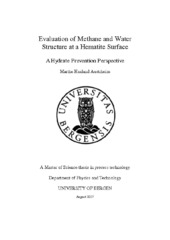Evaluation of Methane and Water Structure at a Hematite Surface - A Hydrate Prevention Perspective
Master thesis
Permanent lenke
https://hdl.handle.net/1956/16731Utgivelsesdato
2017-09-25Metadata
Vis full innførselSamlinger
Sammendrag
In Norway oil and gas is found in reservoirs below the North Sea and the Barents Sea. When this is transported through pipelines it is exposed to temperatures and pressures in the hydrate stability zone. If sufficient amounts of water are present in the fluid steam, hydrates may form and plug the pipelines. Mineral surfaces may structure the water present in the fluid stream, as well as function as adsorption sites for water, and enhance the possibility for hydrate formation. Different routes to hydrate formation are investigated by a thermodynamic approach and it is concluded that the formation route involving hematite is the one which allows the lowest amount of water present to form hydrates. Based on this a system consisting of hematite, water and methane with conditions in the hydrate stability zone is further studied by molecular dynamics simulations. A second system with the addition of a PVP inhibitor is then studied. Two models for water (modified TIP3P and TIP4P/2005) were evaluated but a correct density could not be provided. Methane was hypothesized to be located in the low-density layers of water near the surface but instead the results indicate that they prefer to be located in the high-density layers. The PVP inhibitor does not seem to have any significant effect on structuring water in the systems. None of the system showed any clear signs of hydrate structures starting to form.
